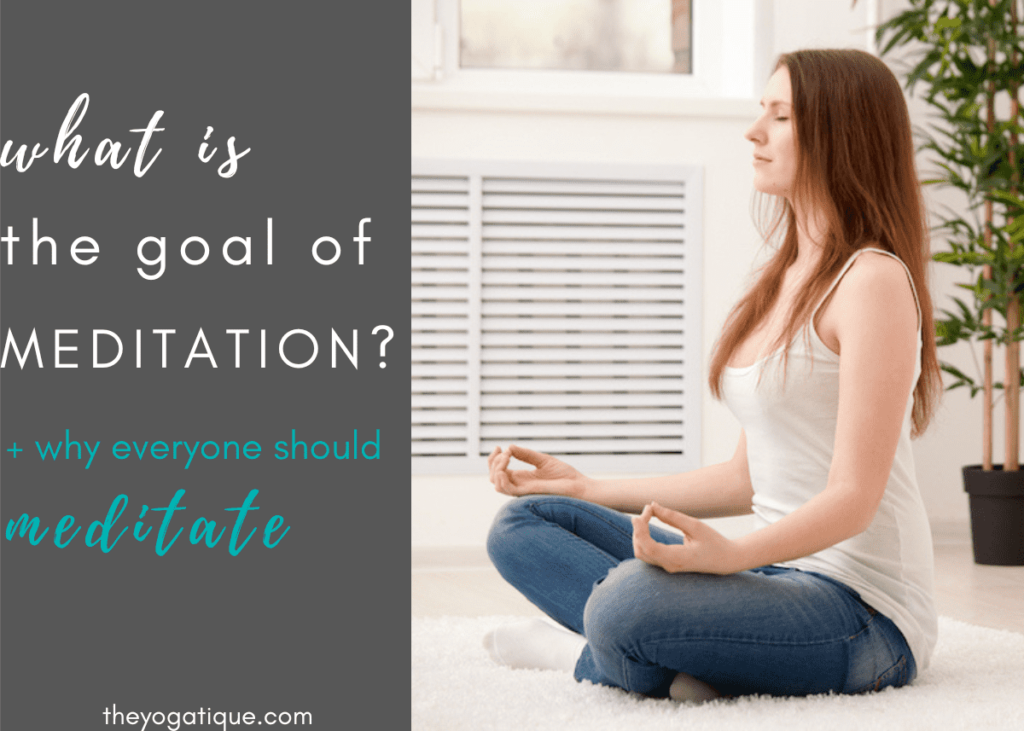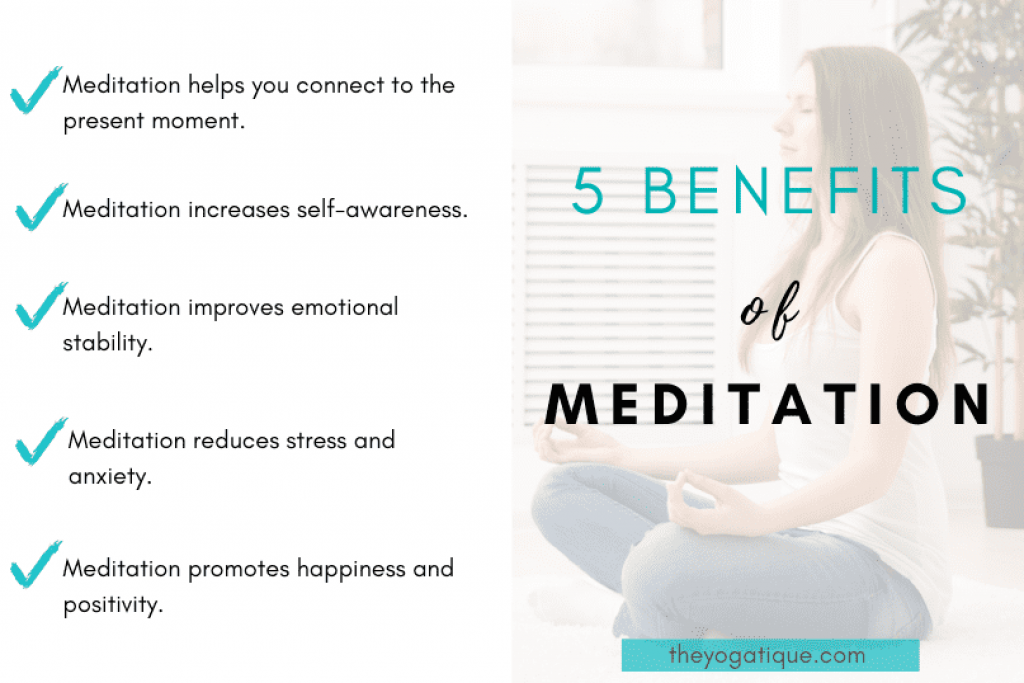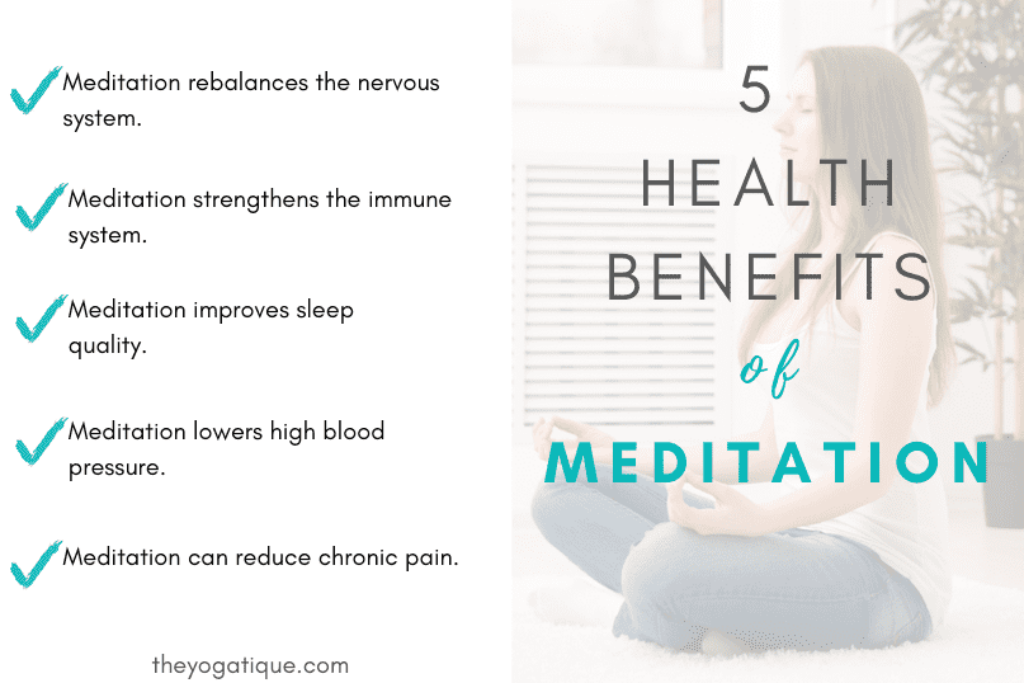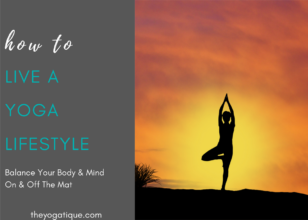
You've probably heard that meditation can help you feel calmer and less stressed? And while many of us now practice meditation to feel calmer, did you know that stress reduction was not necessarily the traditional purpose of meditation? And furthermore, stress reduction is not actually the only goal of this ancient practice. If you’ve been curious to discover more about what is the goal of meditation and how it can benefit you, keep reading to learn more about how to incorporate different types of meditation into your life and the vast benefits of establishing a meditation practice.
In this article, we’ll also explore the various meditation styles and how the objective of meditation differs from type to type.
If you want to understand how meditation can help you achieve more focus, alertness, clarity, joy, creativity, peace, calm, and balance, grab your tea and join us in diving deeper into the goals of meditation!
Article content:
(Click any link below to jump directly to section)
Benefits of meditation an overview
5 benefits of having a daily meditation practice backed up by science
5 health benefits of meditation
3 types of common meditation practice
How to meditate – 6 steps to achieve peace & clarity
Bonus meditation tips
Takeaway on what is the goal of meditation
FAQ about the goal of meditation
Benefits of meditation an overview
You may have heard that the basic concept of meditation is to unite the body and mind. Or that the primary purpose of meditation is to see your thoughts or help you achieve moksha, or liberation.
Meditation can also help you to realize the nature of your true self. This is known as atman, according to Hindu teachings that are studied in meditation certification courses.
Meditation helps to cultivate more mindfulness and mental stillness, which is what, for many people, is the goal of yoga. Mindfulness and mental stillness can be achieved by directing your focus on one thing, such as your body, the breath, or a mantra.
It is estimated that most people have over 6,000 thoughts per day, many of which are repetitive and pessimistic. And what many people don’t realize is that the goal of meditation is not to clear the mind entirely but rather to reduce the number of unwanted thoughts.
To explain further, the practice of meditation helps to increase the space between each thought. So instead of restlessly and uncontrollably jumping from one idea to another (known as the monkey mind in Buddhism), we create more space between each one. This help to achieve more mental peace and clarity and unlock joy and creativity from within.
This space reduces mental activity, greatly improving focus and clarity. In yoga therapy training it is taught that goal of meditation is to gain control over your mind, so that you can maintain your attention on the present moment without getting distracted by every little thing.
When you’re able to master your mind in this way, you experience a deeper sense of peace and greater ease.
Here are five benefits of having a daily meditation practice, backed up by science

In recent years, many scientific studies have been done on the benefits of yoga therapy and on the benefits of meditation, and a huge percentage of the human population has tried to incorporate meditation into their daily lives – maybe even you!
If you need just a little more encouragement to establish a solid meditation practice, see 5 benefits below.
5 benefits of meditation
1. Meditation helps you connect to the present moment
Many of us lead hectic lifestyles where we are always busy going from one thing to the next. What's more, mentally, we are always thinking about the future or the past. Thus, we never take time to pause and be in the present moment.
Mindful practices like meditation and kundalini yoga help us do just that, which is why we feel a sense of inner peace after we have sat down to meditate. With long-term mindfulness practice, you can train your mind to stay focused on the present rather than letting it wander to worries of tomorrow or regrets of yesterday.
2. Meditation increases self-awareness
A long-term and regular meditation practice increases self-awareness by creating more clarity in our minds. With lower mental activity, we see our thoughts for what they really are, destructive inner commentary that is often not true.
Similarly, meditation increases awareness of our unconscious brain activity. The unconscious mind stores all our memories and experiences that we do not consciously think about but form our limiting beliefs, habits, and desires. Thus, accessing the subconscious mind allows us to discover new parts of ourselves.
3. Meditation improves emotional stability
As we become more present, we notice our thoughts and emotions and learn how to let them go. Mindfulness meditation teaches you to see feelings like clouds in the sky; you notice them and simply let them pass without trying to push them away.
The act of allowing emotions to come and go removes the energetic charge of that feeling. This can reduce the number of negative emotions, improving emotional stability and regulation.
4. Meditation reduces stress and anxiety & increases compassion
A Yale University study found that meditation decreases activity in the default mode network (DMN). This is the area of the brain responsible for excessive and repetitive thoughts.
An overactive DMN can result in anxiety as it triggers the mind to create worrisome thoughts about future events. Meditation decreases activity in the DMN and, thus, reduces anxious thoughts.
In addition, yoga therapists and yoga teachers teach us that meditation changes our perception of stress. This means fewer things may cause you to stress out, and help you to handle stressors more effectively. Better stress management – yes please!
5. Meditation promotes happiness, positivity & empathy
Research has also found that daily meditation can lower the levels of neuroticism. This broad personality trait is responsible for a host of negative feelings like anxiety, sadness, irritability, and self-consciousness.
Positive thinking and feelings of happiness are a natural result of the stress and anxiety reduction qualities of practicing meditation. A yoga therapist might prescribe meditation to help with accepting and letting go of negative thoughts and emotions to help create space for more positive ones.
5 health benefits of meditation

Aside from the benefits to our mental and emotional well-being, meditation also improves our physical health in many ways, such as:
1. Meditation rebalances the nervous system
Meditation triggers the relaxation response of the parasympathetic nervous system. This induces various anti-oxidation and anti-inflammatory changes in the body, which can reduce symptoms of several medical conditions.
2. Meditation strengthens the immune system
Research has found that meditation boosts the activity of the genes that regulate the immune response.
3. Meditation improves sleep quality
Along with the calming effect on the nervous system, meditation improves sleep by increasing melatonin.
4. Meditation lowers high blood pressure
Studies have shown that meditation may increase nitric oxide levels, which widens blood vessels to allow better blood flow.
5. Meditation can reduce chronic pain
This is because of meditation's effects on neuroplasticity. Over time, the practice can change your brain structure to make you less sensitive to pain.
3 types of common meditation practice
While there are over a dozen styles of meditation, here are the three most common types.
1. Mindfulness meditation
Mindfulness meditation is one of the most popular styles practiced in the western world. The goal of mindfulness meditation is to increase your awareness of what you are sensing and feeling in the present moment.
However, the key is to observe the thoughts and feelings only, rather than try to understand them or judge yourself.
2. Breath awareness meditation
Breath awareness is similar to mindfulness meditation, but rather than focusing on all bodily sensations, you focus purely on your breath. Also known as vipassana meditation, this technique has been taught in India for over 2500 years. You typically focus on the rise and fall of the belly or the air entering and leaving your nose when practicing vipassana.
3. Mantra meditation
In mantra meditation, you focus on a particular word or phrase. This could be a Sanskrit mantra or any word that has meaning for you. The mantra serves as your focal point, and you can either repeat it silently in your head or chant it out loud. Repeating a word or phrase effectively quiets the mind and cultivates a deeper connection with yourself.
How to meditate – 6 steps to achieving peace & clarity
Now that you better understand what is the goal of meditation, why not put it into practice? Here are some basic guidelines for how you can meditate for the first time.
1. First, find a calm and quiet environment free from distractions.
You might find it helpful to set the mood by playing some relaxation music or lighting candles or incense.
2. Come into a comfortable posture.
The traditional position is cross-legged, but I recommend sitting on a cushion or pillow to elevate the hips and relieve tension. If cross-legged doesn't work for you, simply extend your legs and sit with your back against the wall.
3. Close your eyes and become aware of your body.
Notice any sensations you may feel. If you observe any tension, consciously soften and relax those body parts.
4. Bring your awareness to your breathing.
Take three deep and full breaths, inhaling through the nose and exhaling through the mouth.
5. Start to breathe normally with conscious awareness
Bring conscious awareness to each part of the breath; the inhale, the exhale, and the space between.
6. Don't worry if your mind keeps wandering, relax
Bonus meditation tips
Whenever you notice a thought, remind yourself to return to your breath and continue focusing on each inhale and exhale.
I recommend setting a timer, starting with five minutes and gradually increasing the duration as you get more comfortable with the practice. Those are easy ways to help you make meditation a habit.
You can also practice mindfulness by following a guided meditation aimed at beginners. You will find many free guided meditations on Youtube and meditation and yoga apps like Insight Timer and Headspace.
Takeaway on what is the goal of meditation
People practice meditation for different reasons, from reducing stress to learning how to maintain balance in life. So when thinking about what is the goal of meditation, not only does it differ between traditions, but it also depends on your personal needs.
Still, remember that meditation is not about freeing your mind from all thoughts but instead quieting the mental chatter a bit. With each meditation session, you’ll regain control of your mind and experience improved health and well-being.
Om shanti shanti and happy meditating.
FAQ about the goal of meditation
What is the basic rule of meditation?
Focus your attention on the breath and on how the body moves with each inhalation and exhalation. Allow thoughts to come and go without feeling anxious about that process. Notice how your body moves as you breathe.
How long should you meditate?
A novice may begin by meditating for just 5 minutes each day. More advanced meditators may meditate 40-50 minutes each day in two sessions. Meditation is a practice that you will need to ease into, but there really are no “shoulds” in meditate.
Some online yoga studios, online yoga teacher training programs, and brands that we write about may offer us a small commission should you decide to make a purchase or signup after reading our content. Thank you for enabling us to exist!






